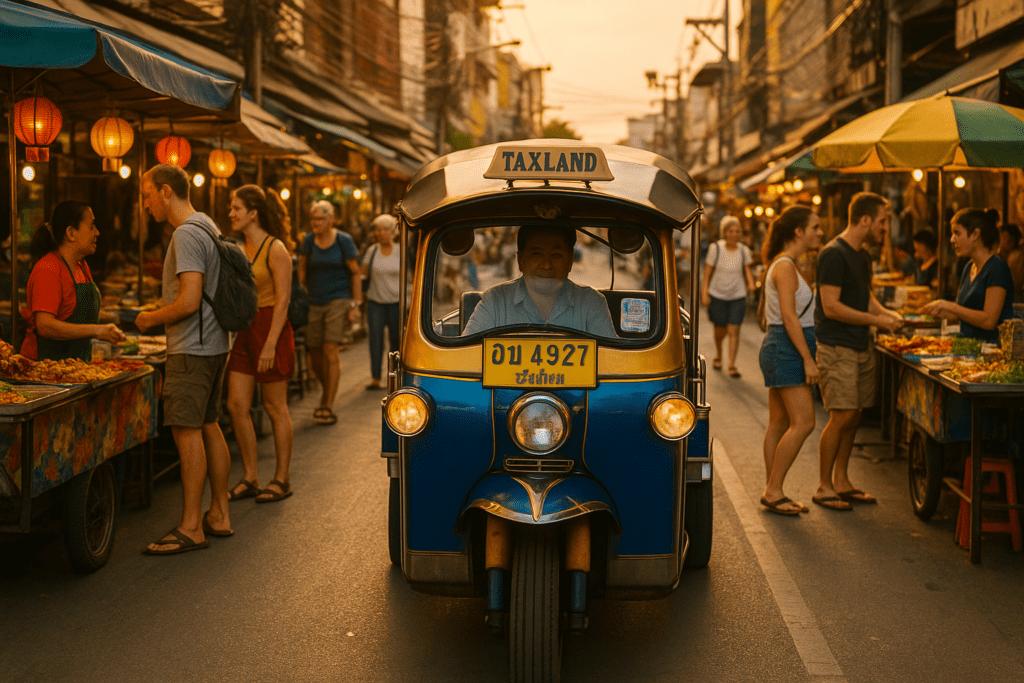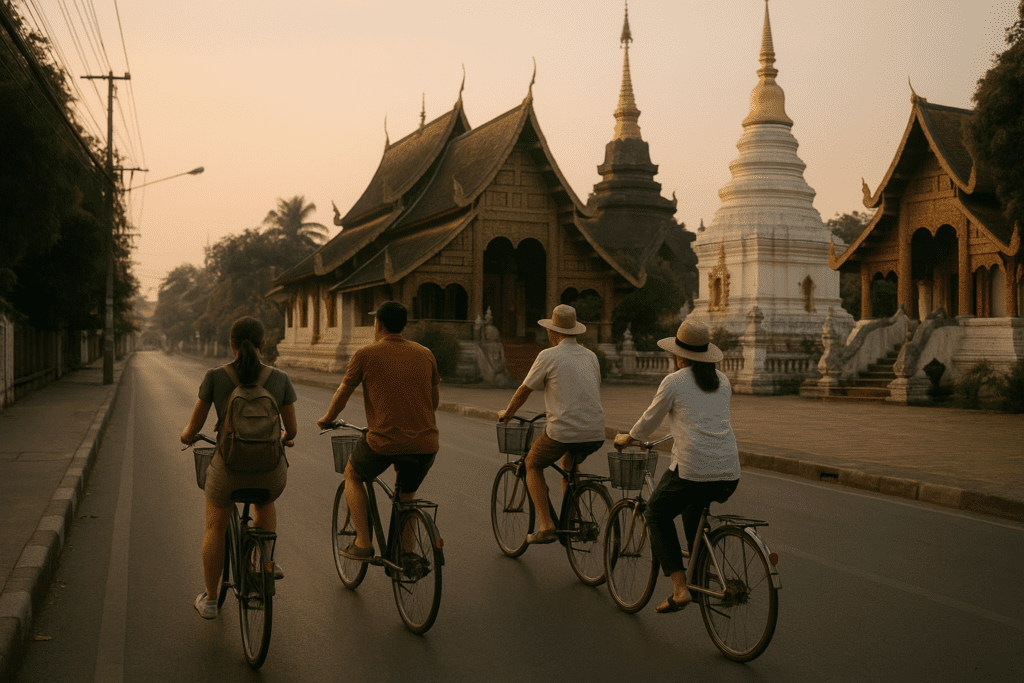Estimated reading time: 8 minutes
Key Takeaways
- Understanding Chiang Mai’s transport options can save you hundreds of baht daily compared to relying solely on tuk-tuks
- Red songthaews offer the best value at ฿30 per ride, while RTC City Buses cost ฿20-50 and cover major tourist routes
- The Old City is perfect for walking, while Nimman and Night Bazaar areas are easily connected by public transport
- Always negotiate tuk-tuk prices upfront and confirm fares before starting your journey
- Grab app provides transparent pricing and eliminates language barriers for stress-free rides
- Motorbike rentals (฿150-300/day) offer maximum freedom but require safety awareness and proper helmets
Table of Contents

Figuring out how to get around Chiang Mai is absolutely crucial for any traveler wanting a smooth, stress-free trip. I learned this the hard way during my first visit when I spent way too much on tuk-tuks and got completely lost trying to find the right bus stop.
Understanding Chiang Mai’s transport system isn’t just about convenience—it’s about saving serious money, avoiding tourist traps, and actually having time to explore those incredible temples, cozy cafes, and bustling night markets instead of standing around confused on street corners. When you know your options, you can spend more time sipping that perfect Thai iced coffee in Nimman and less time overpaying for rides.
The city offers an impressive range of Chiang Mai transportation options: public city buses, those iconic red songthaews (shared trucks), classic tuk-tuks, motorbike taxis, the reliable Grab app, walking, cycling, and even e-scooters for the adventurous. Each has its sweet spot depending on where you’re going, how much you want to spend, and your comfort level with local transport. Learn more about transport options on GetYourGuide
I promise this guide won’t just list every transport method—I’ll show you the cheapest way to travel Chiang Mai and share the kind of insider Chiang Mai transport tips that’ll have you navigating like a local within hours of landing.

Why Planning Your Chiang Mai Transport is Essential
Look, I get it. Planning transport sounds about as exciting as watching paint dry. But trust me on this one—a little prep work goes a ridiculously long way in Chiang Mai.
Save Money
Your transport choices can literally make or break your travel budget. Using budget-friendly songthaews at a flat ฿30 fare per ride or hopping on the RTC City Bus for ฿20-50 will save you hundreds compared to relying on tuk-tuks or private taxis for every trip. I’ve watched travelers blow through 2,000 baht in a day just on transport when they could’ve spent maybe 200 baht and had money left over for that cooking class they really wanted to try.
Avoid Stress
Nothing kills the travel vibe like standing in 95-degree heat trying to negotiate with a tuk-tuk driver who’s clearly overcharging you. Using reliable options like the Grab app gives you upfront pricing, or public buses with real-time tracking through apps like CM Transit eliminates all that guesswork and awkward haggling. Read more about transport options at TripCorner
Maximize Your Sightseeing Time
Here’s a quick mental map of Chiang Mai that’ll help you plan smarter routes:
The Old City is the historic heart—think ancient temples, traditional markets, and that famous Sunday Walking Street. It’s enclosed by a moat and crumbling walls, making it super compact and perfect for exploring on foot.
Nimmanhaemin (everyone just calls it Nimman) sits west of the Old City and screams modern Thailand. This is where you’ll find those Instagram-worthy coffee shops, trendy boutiques, and the kind of nightlife that doesn’t involve ping pong shows.
The Night Bazaar area sprawls east of the Old City. Come evening, this place transforms into street food heaven and souvenir shopping central.
Chiang Mai International Airport sits conveniently southwest of the Old City. Getting there is actually pretty straightforward with buses, songthaews, or Grab rides taking 20-30 minutes depending on traffic.
Understanding these zones means you can chain activities together efficiently instead of ping-ponging across the city randomly.

The Ultimate Breakdown of Chiang Mai Transportation Options
Alright, let’s dive into every single way you can get around this city, from the ultra-local to the tourist-friendly.
Walking & Cycling
Walking is honestly your best friend in the Old City. Those narrow sois (side streets) between temples are made for wandering, and you’ll discover tiny shrines and family-run restaurants you’d miss from any vehicle.
Bike rentals are everywhere, but here’s the thing—stick to the quieter streets. The main roads can feel like organized chaos, especially during rush hour. Save cycling for early morning temple runs or lazy afternoon rides through residential areas.
Motorbike and Scooter Rental
This is where things get interesting. Renting a scooter (฿150–฿300 per day) gives you incredible freedom to explore places like the stunning temples up in the mountains or that hidden waterfall everyone’s posting about.
But let’s be real about safety. Helmets aren’t just recommended—they’re mandatory and could literally save your life. Traffic here has its own rhythm that takes time to understand. If you’ve never ridden in Southeast Asian traffic before, maybe practice in quieter areas first.
For travelers who want that freedom without the hassle of finding a reputable rental shop on arrival, you can actually pre-book a quality, well-maintained bike through Byklo.rent, ensuring your ride is ready when you land. For more insider tips and to save on rentals, check out our Motorbike Rental Chiang Mai guide. Want to plan scenic rides? See our Top 10 Scenic Motorbike Routes Around Chiang Mai and learn how to link your rides with temple visits in our Exploring Chiang Mai’s Temples by Motorbike post.
Red Songthaews (Shared Red Trucks)
These red pickup trucks with covered beds are absolutely iconic Chiang Mai. Here’s how they work: flag one down, tell the driver your destination (pointing at a map works great), hop in the back with other passengers, and pay ฿30 in cash when you get off.
The beauty is in their simplicity. No apps, no surge pricing, no complicated routes to memorize. They can also be hired privately for day trips—perfect when you want to visit multiple temples or head out to markets outside the city center. For more extensive day-trip planning—from Doi Inthanon to Pai—check out our Best Day Trips from Chiang Mai.
Tuk-Tuks
Those three-wheeled yellow and red vehicles are fun as hell and perfect for short, direct trips. But here’s the crucial part: always negotiate and agree on the price before you get in. I cannot stress this enough. A typical ride costs ฿60–฿150, but prices can vary wildly depending on your negotiation skills and the driver’s assessment of your tourist-ness.
Some drivers might try to upsell you on shopping stops or tours. It’s not necessarily a scam, but know that they’re getting commissions, so those “special prices” at silk shops might not be so special. Learn more about tuk-tuks on Lonely Planet
Grab (Ride-Hailing App)
Grab is Southeast Asia’s Uber, and it’s honestly a game-changer for tourists. You get upfront pricing, can pay with a credit card, and there’s zero language barrier since everything’s handled through the app.
GrabCar gets you air-conditioned comfort, while GrabBike is perfect for solo travelers who want to zip through traffic quickly. Yes, it costs more than public transport, but the convenience factor is huge, especially late at night or when you’re carrying shopping bags.
Public Buses (RTC City Bus)
These modern, air-conditioned buses are seriously underrated by tourists. At ฿20-50 per ride, they’re incredibly affordable and actually quite comfortable. You can pay with cash or get a rechargeable Rabbit card for even more convenience.
The buses cover all the major routes tourists need, connecting the airport, Old City, Nimman, and key shopping areas. Download the CM Transit app to track buses in real-time—it’s surprisingly accurate.
Sample Itineraries & Transport Choices
Let’s put all this information into practice with real-world scenarios:
| Journey | Cheapest Option | Fastest Option | Most Comfortable Option |
|---|---|---|---|
| Airport → Old City | RTC City Bus (฿50) | GrabCar (approx. 15-20 mins) | GrabCar (A/C, door-to-door service) |
| Old City Temple Loop | Walk / Shared Songthaew (฿30 per hop) | Private Tuk-tuk hire (negotiate a fixed price for 2-3 hours) | Private Songthaew/Grab hire (Set your own pace) |
| Old City → Night Bazaar | Shared Songthaew (฿30) | Tuk-tuk (approx. 10 mins) | GrabCar (Avoids haggling in a busy area) |
To plan a memorable evening at the Night Bazaar and explore Chiang Mai’s best markets, see our Chiang Mai Night Markets guide.

Top Chiang Mai Transport Tips for a Smooth Journey
These are the Chiang Mai transport tips that actually matter in real-world situations.
Bargaining Etiquette
Always negotiate with a smile and friendly attitude. State your proposed price clearly, be prepared to meet somewhere in the middle, and absolutely confirm the final price before starting your journey. Thai people appreciate politeness, so a little wai (hands pressed together in prayer position) goes a long way.
Safety Pointers
Helmets are mandatory on motorbikes and scooters—not just for legal reasons, but because traffic here can be genuinely unpredictable. Intersections are particularly chaotic since not everyone follows traffic lights religiously.
During rainy season (roughly June to October), roads become slippery and visibility drops. If you’re not comfortable riding in these conditions, stick to cars or covered transport.
Navigating Peak Hours
Avoid major roads during morning rush hour (7:00–9:00 AM) and evening rush hour (4:30–7:00 PM). Traffic doesn’t just slow down—it practically stops, especially near schools and major shopping areas.
Useful Thai Phrases for Transport
- Pai… (pronounced “bye”) – “Go to…” (just point at your destination on a map)
- Ra-ka tao-rai? – “How much is the fare?”
- Lot noi dai mai? – “Can you lower the price a little?”
- Jot tee nee – “Stop here”
- Khop khun (khrap/kha) – “Thank you” (use khrap if you’re male, kha if you’re female)
Most drivers appreciate any attempt at Thai, even if your pronunciation is terrible. It shows respect and often results in better service.
Ready to Navigate Chiang Mai Like a Pro?
Chiang Mai’s transport system really does have something for every budget and travel style. Whether you’re pinching every baht with songthaews and buses, embracing the convenience of Grab, or seeking adventure with a rental scooter, the key is mixing and matching based on the situation.
Walk the compact Old City to soak in the atmosphere, take a songthaew to trendy Nimman for lunch, and use Grab to get back to your hotel late at night after exploring the night markets. This flexible approach gives you the best of all worlds—authentic experiences, reasonable costs, and comfort when you need it most.
The city becomes infinitely more enjoyable when you’re not stressed about how to get from point A to point B. With these options in your back pocket, you can focus on what really matters: discovering incredible temples, tasting amazing food, and creating memories that’ll last long after you’ve returned home.
Don’t forget, if you want ultimate freedom on two wheels, rent a motorbike from Byklo.rent and explore Chiang Mai at your own pace!
Frequently Asked Questions
What’s the cheapest way to get around Chiang Mai?
The cheapest transport options are red songthaews at ฿30 per ride and RTC City Buses at ฿20-50. Walking within the Old City is free and highly recommended for short distances between temples and attractions.
Is it safe to rent a motorbike in Chiang Mai?
Yes, but safety precautions are essential. Always wear a helmet (it’s mandatory), stick to quieter streets if you’re inexperienced, and avoid riding during heavy rain or rush hours. Consider practicing in less busy areas first if you’re new to Southeast Asian traffic.
How much should I pay for a tuk-tuk ride in Chiang Mai?
Typical tuk-tuk rides cost ฿60-150 depending on distance and your negotiation skills. Always agree on the price before getting in, and don’t be afraid to politely negotiate or walk away if the price seems too high.
Does Grab work well in Chiang Mai?
Yes, Grab is reliable and widely available in Chiang Mai. It offers upfront pricing, accepts credit cards, and eliminates language barriers. Both GrabCar and GrabBike are available, with cars being more comfortable and bikes being faster in traffic.
How do I use the red songthaews in Chiang Mai?
Simply flag one down, tell the driver your destination (pointing at a map works well), hop in the back with other passengers, and pay ฿30 in cash when you get off. They operate on flexible routes and are one of the most authentic ways to travel like a local.
What’s the best transport for getting from Chiang Mai airport to the Old City?
For budget travelers, take the RTC City Bus for ฿50. For convenience and comfort, use GrabCar which takes 15-20 minutes door-to-door. Red songthaews are also available but may require transfers depending on your exact destination.


